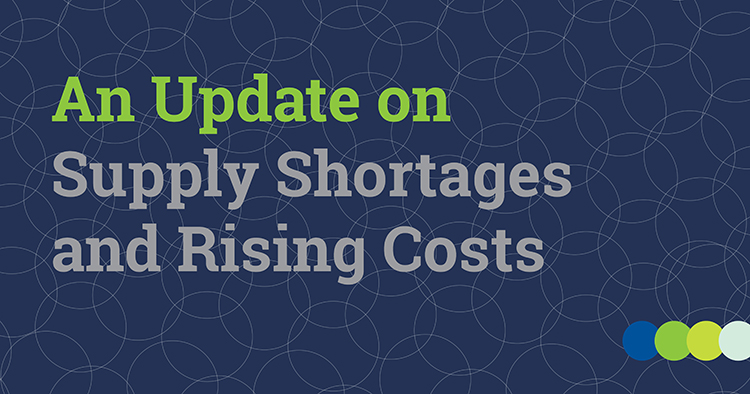An Update on Supply Shortages and Rising Costs
Posted on Wednesday, May 18th, 2022 by Affinis CorpIn Project Strategies, tagged in

In today’s blog post, we’re discussing a timely issue – supply chain shortages and rising costs. Here, Addison Miller, PE, Traffic Engineer and Jacob Wilson, Project Engineer share what they’ve seen and offer their perspective on navigating delays.
Tell me a little about the shortages and delays you’ve seen.
Addison: For traffic equipment, any made-to-order materials are seeing an increased delay in manufacturing and delivery times. For example, traffic signal poles made to a certain city’s specifications or a particular length are impacted.
Jacob: At my previous employer (that I left a little more than a year ago), the biggest challenge that I recall was an asphalt contractor struggling to acquire the needed oil for their mix. COVID and flooding had made transportation of the needed oil very difficult. I also saw some difficulties with guardrail suppliers for specific products. However, we were able to navigate those challenges. The biggest issue impacting the clients I work with is the increase in costs.
What can clients expect?
Addison: Clients can expect longer wait times for made-to-order equipment and to see increased prices across the board for all equipment.
Jacob: As I mentioned, I think the most noticeable issue is the rising costs of materials, particularly oil, which has been impacted by the war in Ukraine. Not only does it affect oil prices, it also increases the associated shipping costs of all other materials due to rising fuel prices.
How long do you think these shortages and delays will impact projects?
Addison: I’m not sure. At this point, it seems as if this could become an ongoing issue. At our Industry Summit, Economist Dr. Chris Kuehl suggested that these issues may take a while to resolve.
Jacob: I think the impact of these shortages and delays will potentially be felt for years – if not decades. All these things that have happened and are happening have ripple effects which can’t always be known at the moment. Cities, counties, and states only have so much revenue. If they need to spend more on a current project, it will affect and limit their ability to do other important projects.
What strategies can clients use when navigating these longer timelines?
Addison: At this point, I’d plan to adjust expectations for project and construction timelines. Plan ahead as much as possible and try to procure any items with long lead times early in the process.
Jacob: I wouldn’t say that flexibility is a strategy, but I do think it’s critical. With constant change in the market, having the ability to adapt to material availabilty and fluctuating costs will be key.
What has been successful for other clients with whom you’ve worked?
Addison: I have had clients order some equipment themselves during the design process, so they will have it in time for the beginning of construction rather than waiting until after the project is bid and having the contractor order the items for them. That being said, this increases liability for the client, as they are providing the materials to the contractor rather than the manufacturer supplying them.